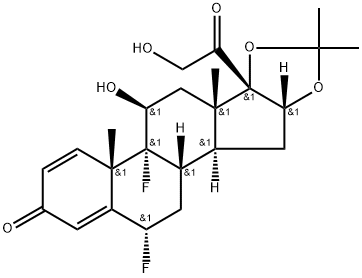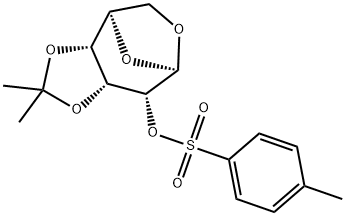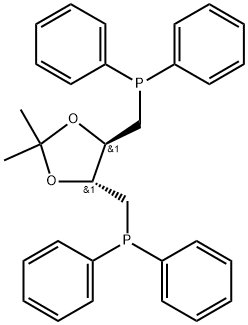2,2,4-TRIMETHYL-1,3-DIOXOLANE
- CAS NO.:1193-11-9
- Empirical Formula: C6H12O2
- Molecular Weight: 116.16
- MDL number: MFCD00090841
- EINECS: 214-766-0
- SAFETY DATA SHEET (SDS)
- Update Date: 2025-09-25 17:15:13

What is 2,2,4-TRIMETHYL-1,3-DIOXOLANE?
Chemical properties
2,2,4-Trimethyl-1,3-oxacyclopentane has a mild, musty-like and sweet odor.
Occurrence
Reported found in tomato, lingonberry, cowberry (Vacinium vitis idaea L.) and tomato.
Preparation
From acetone and propylene glycol.
Definition
ChEBI: 2,2,4-Trimethyl-1,3-dioxolane is a ketal.
Taste threshold values
Taste characteristics at 25 ppm: green, earthy, vegetative and musty with tomato and potato nuances.
Properties of 2,2,4-TRIMETHYL-1,3-DIOXOLANE
| Boiling point: | 98°C |
| Density | 0.897 |
| refractive index | 1.3930-1.3970 |
| FEMA | 3441 | 2,2,4-TRIMETHYL-1,3-OXACYCLOPENTANE |
| Flash point: | 98°C |
| storage temp. | Refrigerator |
| solubility | DMSO (Slightly), Methanol (Slightly) |
| form | Oil |
| color | Colourless |
| Odor | at 100.00 %. earthy ethereal green vegetable asparagus raw potato tomato tomato leaf |
| JECFA Number | 929 |
Safety information for 2,2,4-TRIMETHYL-1,3-DIOXOLANE
| Signal word | Warning |
| Pictogram(s) |
 Flame Flammables GHS02  Exclamation Mark Irritant GHS07 |
| GHS Hazard Statements |
H226:Flammable liquids H315:Skin corrosion/irritation H319:Serious eye damage/eye irritation H335:Specific target organ toxicity, single exposure;Respiratory tract irritation |
| Precautionary Statement Codes |
P210:Keep away from heat/sparks/open flames/hot surfaces. — No smoking. P233:Keep container tightly closed. P240:Ground/bond container and receiving equipment. P261:Avoid breathing dust/fume/gas/mist/vapours/spray. P264:Wash hands thoroughly after handling. P264:Wash skin thouroughly after handling. P280:Wear protective gloves/protective clothing/eye protection/face protection. P303+P361+P353:IF ON SKIN (or hair): Remove/Take off Immediately all contaminated clothing. Rinse SKIN with water/shower. P305+P351+P338:IF IN EYES: Rinse cautiously with water for several minutes. Remove contact lenses, if present and easy to do. Continuerinsing. P370+P378:In case of fire: Use … for extinction. P405:Store locked up. P403+P235:Store in a well-ventilated place. Keep cool. P501:Dispose of contents/container to..… |
Computed Descriptors for 2,2,4-TRIMETHYL-1,3-DIOXOLANE
New Products
4,4-Difluoropiperidine hydrochloride tert-butyl 9-methoxy-3-azaspiro[5.5]undecane-3-carboxylate Indole Methyl Resin N-Isopropylurea N,N-Dicyclohexylcarbodiimide(DCC) MELDRUMS ACID 5-METHYLISOXAZOLE-4-CARBOXYLIC ACID Magnessium Bis glycinate Zinc ascorbate 1-bromo-2-butyne 2-acetamidophenol 9(10H)-anthracenone Erythrosin B, 4-Piperidinopiperidine 2-((4-morpholinophenylamino) (methylthio) methylene) malononitrile 2,4-dihydroxybenzaldehyde 3-(4-morpholinophenylamino)-5-amino-1H-pyrazole-4-carbonitrile Methyl 2-methylquinoline-6-carboxylate 2,6-dichloro-4-nitropyridine 4-Bromo-2-chlorobenzonitrile 2-(benzylamino)acetic acid hydrochloride 4-(tert-Butoxycarbonylamino)but- 2-ynoic acid 3,4-dihydro-2H-benzo[b][1,4]dioxepine 1-Phenyl-1-cycloprppanecarboxylicacidRelated products of tetrahydrofuran



![2-methyl-1,4-dioxaspiro[4.5]decane](https://img.chemicalbook.in/CAS/GIF/4722-68-3.gif)




You may like
-
 2,2,4-Trimethyl-1,3-dioxolane CAS 1193-11-9View Details
2,2,4-Trimethyl-1,3-dioxolane CAS 1193-11-9View Details
1193-11-9 -
 2,2,4-TRIMETHYL-1,3-DIOXOLANE CAS 1193-11-9View Details
2,2,4-TRIMETHYL-1,3-DIOXOLANE CAS 1193-11-9View Details
1193-11-9 -
 3-(4-amino-1-oxoisoindolin-2-yl)-1-methylpiperidine-2,6-dione 98%View Details
3-(4-amino-1-oxoisoindolin-2-yl)-1-methylpiperidine-2,6-dione 98%View Details -
 614-19-7 98%View Details
614-19-7 98%View Details
614-19-7 -
 20677-73-0 (2,2-diethoxyethyl)methylamine 98%View Details
20677-73-0 (2,2-diethoxyethyl)methylamine 98%View Details
20677-73-0 -
 3-(4-(hydroxyamino)-1-oxoisoindolin-2-yl)piperidine-2,6-dione 98%View Details
3-(4-(hydroxyamino)-1-oxoisoindolin-2-yl)piperidine-2,6-dione 98%View Details -
 57381-49-4 2-bromo-4-chlorobenzonitrile 98%View Details
57381-49-4 2-bromo-4-chlorobenzonitrile 98%View Details
57381-49-4 -
 4,6-dichloropyrimidine-5-carbaldehyde 98%View Details
4,6-dichloropyrimidine-5-carbaldehyde 98%View Details
5305-40-8
Statement: All products displayed on this website are only used for non medical purposes such as industrial applications or scientific research, and cannot be used for clinical diagnosis or treatment of humans or animals. They are not medicinal or edible.
